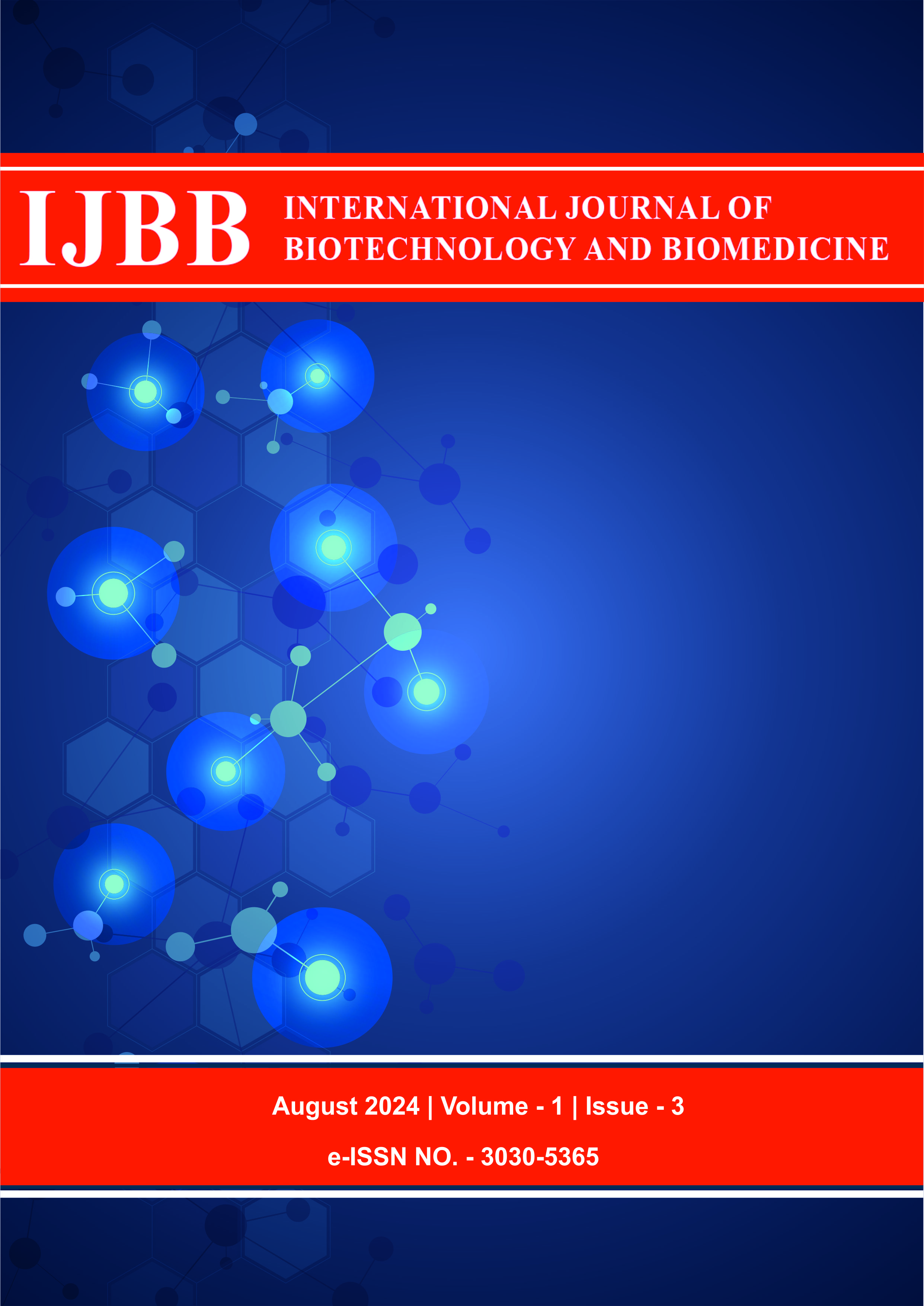A review of Health Management for Stroke Survivors During the Rehabilitation Period
DOI:
https://doi.org/10.31674/ijbb.2024.v01i03.005Abstract
Background: Stroke is a prevalent acute cerebrovascular disorder, After the patient falls ill, it seriously affects their physical and mental health, bringing a heavy burden of care, rehabilitation, and finances to their families. Health management is a management model proposed to prevent and control the occurrence and development of diseases, which is considered an effective means to help stroke patients maintain their health to the maximum extent possible. This study aims to examine the current health management models employed during the rehabilitation period of stroke patients, identify shortcomings in these models, and propose strategies for optimizing the health management and maintenance of patients' health throughout the rehabilitation process. Methods: The relevant literature on health management models in the rehabilitation period of stroke was searched on Cochrane Library, PubMed, Embase, Scopus, Web of Science, CNKI, and WanFang Data systems, and the search time was up to May 2024. Extract and summarize the literature content. Results: For stroke rehabilitation patients, the health management model is in the exploratory stage, with limited content and single intervention methods. A systematic and multi-level health management model has not yet been formed. The health management model does not really connect hospitals, communities, families, and individuals effectively, and the advantages of medical resources and multidisciplinary teams in health management have not been truly reflected. Conclusion: The study shows that the existing health management model should be further improved, including the use of telemedicine technology, strengthening the guidance of hospitals to rehabilitation centers and communities. Government departments need to introduce corresponding policy guarantee mechanisms, give full play to the collaborative power of multidisciplinary teams in hospitals and communities, and improve the effectiveness of health management for stroke patients.
Keywords:
Stroke, Rehabilitation period, Health management, ReviewReferences
Ao, M., Mo, S., Yan, Y., Xie, C., & Ruan, S. (2021). Application of "Internet + Nursing Service" in Stroke Patients in the Model of Healthcare Consortium. J Nurs Train, 36(03), 210-213. doi:10.16821/j.cnki.hsjx.2021.03.005
Collaborators, G. B. D. S. (2021). Global, regional, and national burden of stroke and its risk factors, 1990-2019: a systematic analysis for the Global Burden of Disease Stud y 2019. Lancet Neurol, 20(10), 795-820. doi:10.1016/S1474-4422(21)00252-0
English, C., Ceravolo, M. G., Dorsch, S., Drummond, A., Gandhi, D. B., Halliday Green, J., Schelfaut, B., Verschure, P., Urimubenshi, G., & Savitz, S. (2022). Telehealth for rehabilitation and recovery after stroke: State of the evidence and future directions. Int J Stroke, 17(5), 487-493. doi:10.1177/17474930211062480
Fu, V., Weatherall, M., McPherson, K., Taylor, W., McRae, A., Thomson, T., Gommans, J., Green, G., Harwood, M., Ranta, A., Hanger, C., Riley, J., & McNaughton, H. (2020). Taking Charge after Stroke: A randomized controlled trial of a person- centered, self-directed rehabilitation intervention. International journal of stroke: official journal of the Internationa l Stroke Society, 15(9), 954-964. doi:10.1177/1747493020915144
Fugazzaro, S., Denti, M., Accogli, M. A., Costi, S., Pagliacci, D., Calugi, S., Cavalli, E., Taricco, M., Bardelli, R., & On Behalf Of Look After Yourself, P. (2021). Self-Management in Stroke Survivors: Development and Implementation of the Look after Yourself (LAY) Intervention. Int J Environ Res Public Health, 18(11), 5925. doi:10.3390/ijerph18115925
Gajarawala, S. N., & Pelkowski, J. N. (2021). Telehealth benefits and barriers. The Journal for Nurse Practitioners, 17(2), 218-221. doi:10.1016/j.nurpra.2020.09.013
Ji, L., Gu, Z. e., Li, X., Chen, H., He, L., & Fang, Y. (2022). A study of team resource management in young and middle-aged hemiplegic patients with first-ever stroke. J Nurs Train, 37(10), 934-937. doi:10.16821/j.cnki.hsjx.2022.10.014
Kleindorfer, D. O., Towfighi, A., Chaturvedi, S., Cockroft, K. M., Gutierrez, J., Lombardi-Hill, D., Kamel, H., Kernan, W. N., Kittner, S. J., Leira, E. C., Lennon, O., Meschia, J. F., Nguyen, T. N., Pollak, P. M., Santangeli, P., Sharrief, A. Z., Smith, S. C., Jr., Turan, T. N., & Williams, L. S. (2021). 2021 Guideline for the Prevention of Stroke in Patients With Stroke an d Transient Ischemic Attack: A Guideline From the American Heart Assoc iation/American Stroke Association. Stroke, 52(7), e364-e467. doi:10.1161/STR.0000000000000375
Knepley, K. D., Mao, J. Z., Wieczorek, P., Okoye, F. O., Jain, A. P., & Harel, N. Y. (2021). Impact of Telerehabilitation for Stroke-Related Deficits. Telemedicine journal and e-health : the official journal of the Americ an Telemedicine Association, 27(3), 239-246. doi:10.1089/tmj.2020.0019
Langhorne, P., Ramachandra, S., & Stroke Unit Trialists, C. (2020). Organised inpatient (stroke unit) care for stroke: network meta-analys is. Cochrane Database Syst Rev, 4(4), CD000197. doi:10.1002/14651858.CD000197.pub4
Lau, S. C. L., Judycki, S., Mix, M., DePaul, O., Tomazin, R., Hardi, A., Wong, A. W. K., & Baum, C. (2022). Theory-Based Self-Management Interventions for Community-Dwelling Stro ke Survivors: A Systematic Review and Meta-Analysis. The American journal of occupational therapy : official publication of the American Occupational Therapy Association, 76(4), 7604205010. doi:10.5014/ajot.2022.049117
Lo, S. H. S., Chang, A. M., & Chau, J. P. C. (2018). Stroke Self-Management Support Improves Survivors' Self-Efficacy and O utcome Expectation of Self-Management Behaviors. Stroke, 49(3), 758-760. doi:10.1161/STROKEAHA.117.019437
Lu, Q., Mårtensson, J., Zhao, Y., & Johansson, L. (2019). Living on the edge: Family caregivers' experiences of caring for post- stroke family members in China: A qualitative study. International journal of nursing studies, 94, 1-8. doi:10.1016/j.ijnurstu.2019.02.016
Lutz, B. J., Reimold, A. E., Coleman, S. W., Guzik, A. K., Russell, L. P., Radman, M. D., Johnson, A. M., Duncan, P. W., Bushnell, C. D., Rosamond, W. D., & Gesell, S. B. (2020). Implementation of a Transitional Care Model for Stroke: Perspectives From Frontline Clinicians, Administrators, and COMPASS-TC Implementatio n Staff. The Gerontologist, 60(6), 1071-1084. doi:10.1093/geront/gnaa029
McCurley, J. L., Funes, C. J., Zale, E. L., Lin, A., Jacobo, M., Jacobs, J. M., Salgueiro, D., Tehan, T., Rosand, J., & Vranceanu, A.-M. (2019). Preventing Chronic Emotional Distress in Stroke Survivors and Their In formal Caregivers. Neurocrit Care, 30(3), 581-589. doi:10.1007/s12028-018-0641-6
McLean, G., Band, R., Saunderson, K., Hanlon, P., Murray, E., Little, P., McManus, R. J., Yardley, L., Mair, F. S., & co-investigators, D. (2016). Digital interventions to promote self-management in adults with hypert ension systematic review and meta-analysis. J Hypertens, 34(4), 600-612. doi:10.1097/HJH.0000000000000859
Naqvi, I. A., Strobino, K., Kuen Cheung, Y., Li, H., Schmitt, K., Ferrara, S., Tom, S. E., Arcia, A., Williams, O. A., Kronish, I. M., & Elkind, M. S. V. (2022). Telehealth After Stroke Care Pilot Randomized Trial of Home Blood Pres sure Telemonitoring in an Underserved Setting. Stroke, 53(12), 3538-3547. doi:10.1161/STROKEAHA.122.041020
Nott, M., Wiseman, L., Seymour, T., Pike, S., Cuming, T., & Wall, G. (2021). Stroke self-management and the role of self-efficacy. Disabil Rehabil, 43(10), 1410-1419. doi:10.1080/09638288.2019.1666431
Organization, W. H. (2020). Global health estimates 2020: deaths by cause, age, sex, by country and by region, 2000–2019. In: WHO Geneva, Switzerland.
Organization, W. H. (2021). Global Health Estimates 2020: Disease burden by Cause, Age, Sex, by Country and by Region, 2000-2019. WHO; 2020. In.
Sajatovic, M., Tatsuoka, C., Welter, E., Colon-Zimmermann, K., Blixen, C., Perzynski, A. T., Amato, S., Cage, J., Sams, J., Moore, S. M., Pundik, S., Sundararajan, S., Modlin, C., & Sila, C. (2018). A Targeted Self-Management Approach for Reducing Stroke Risk Factors i n African American Men Who Have Had a Stroke or Transient Ischemic Att ack. American Journal of Health Promotion, 32(2), 282-293. doi:10.1177/0890117117695218
Sarfo, F. S., Ulasavets, U., Opare-Sem, O. K., & Ovbiagele, B. (2018). Tele-Rehabilitation after Stroke: An Updated Systematic Review of the Literature. J Stroke Cerebrovasc Dis, 27(9), 2306-2318. doi:10.1016/j.jstrokecerebrovasdis.2018.05.013
Saywell, N. L., Vandal, A. C., Mudge, S., Hale, L., Brown, P., Feigin, V., Hanger, C., & Taylor, D. (2021). Telerehabilitation After Stroke Using Readily Available Technology: A Randomized Controlled Trial. Neurorehabil Neural Repair, 35(1), 88-97. doi:10.1177/1545968320971765
Sharrief, A. Z., Guzik, A. K., Jones, E., Okpala, M., Love, M. F., Ranasinghe, T. I. J., & Bushnell, C. (2023). Telehealth Trials to Address Health Equity in Stroke Survivors. Stroke, 54(2), 396-406. doi:10.1161/STROKEAHA.122.039566
Sit, J. W., Chair, S. Y., Chan Yip, C. W., Choi, K. C., Lee, D. T., Leung, K. P., Tang, S. W., & Chan, P. S. (2018). Effect of health empowerment intervention for stroke self-management o n behaviour and health in stroke rehabilitation patients. Hong Kong medical journal = Xianggang yi xue za zhi, 24 Suppl 2(1), 12-15.
Swarthout, M., & Bishop, M. A. (2017). Population health management: Review of concepts and definitions. American journal of health-system pharmacy : AJHP : official journal o f the American Society of Health-System Pharmacists, 74(18), 1405-1411. doi:10.2146/ajhp170025
Wood, J. G. (2016). Collaborative Care on the Stroke Unit: A Cross-Sectional Outcomes Stud y. The Journal of neuroscience nursing : journal of the American Associat ion of Neuroscience Nurses, 48(5), E2-E11. doi:10.1097/JNN.0000000000000226
Ye, M., & Zhou, L. (2020). Research progress on stroke health management models. Nurs J Chin PLA, 37(6), 62-64. doi:1 0.3 9 6 9/j.issn.1 008-9 9 9 3.2020.0 6.0 1 6
Zhou, D., & Tang, W. (2019). The trends of age change in stroke patients and risk factors of young and middle-aged stroke patients. LABORATORY MEDICINE AND CLINIC, 16(02), 211-213. doi:10 .3969/j.issn .1672-9455 .2019 .02 .020
Zhu, J., Di, H., Ji, C., Yuan, P., & Chen, L. (2022). Relationships among exercise self-efficacy, exercise plan and exercise compliance in young and middle aged stroke patients. JOURNAL OF NURSING SCIENCE, 37(23), 36-39. doi:10.3870/j.issn.1001-4152.2022.23.036





